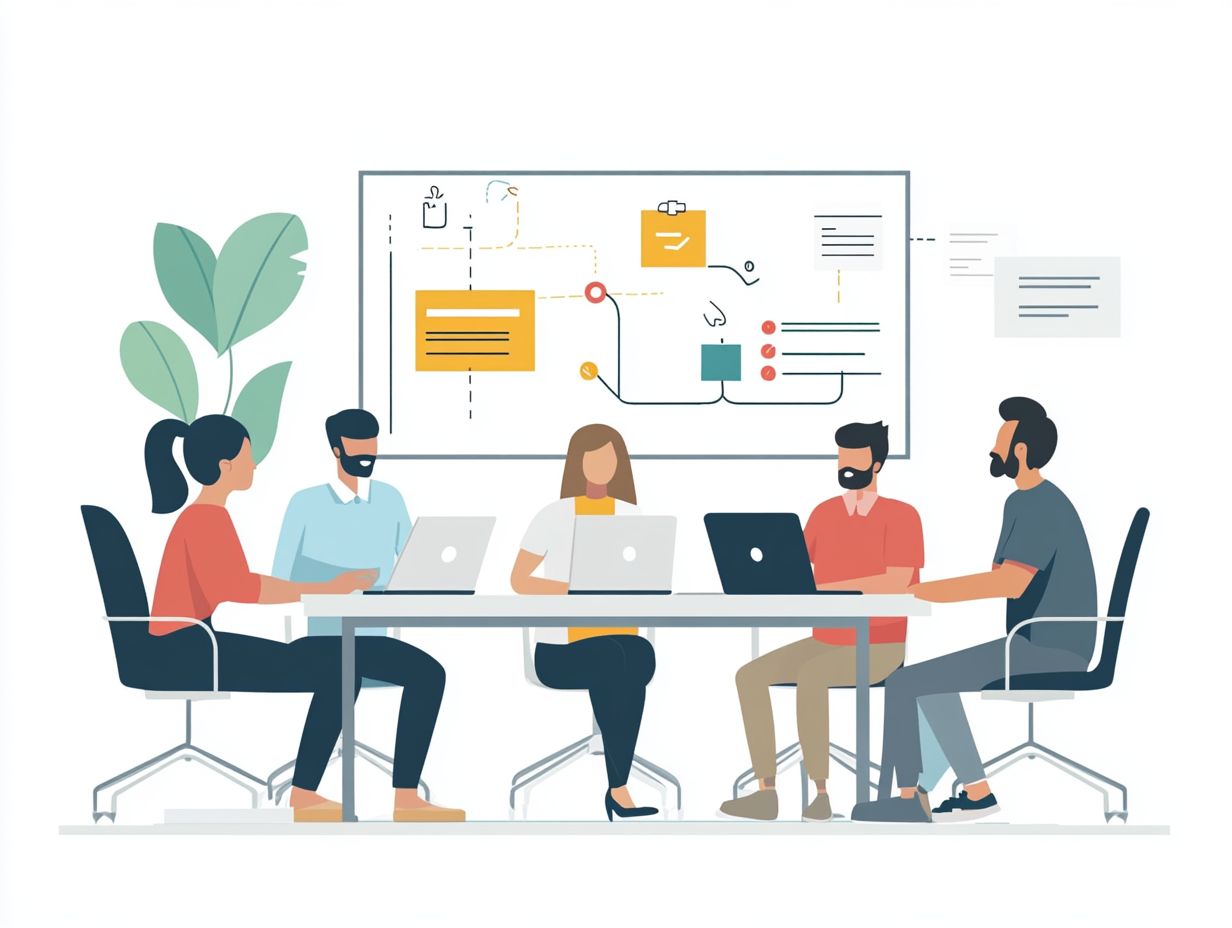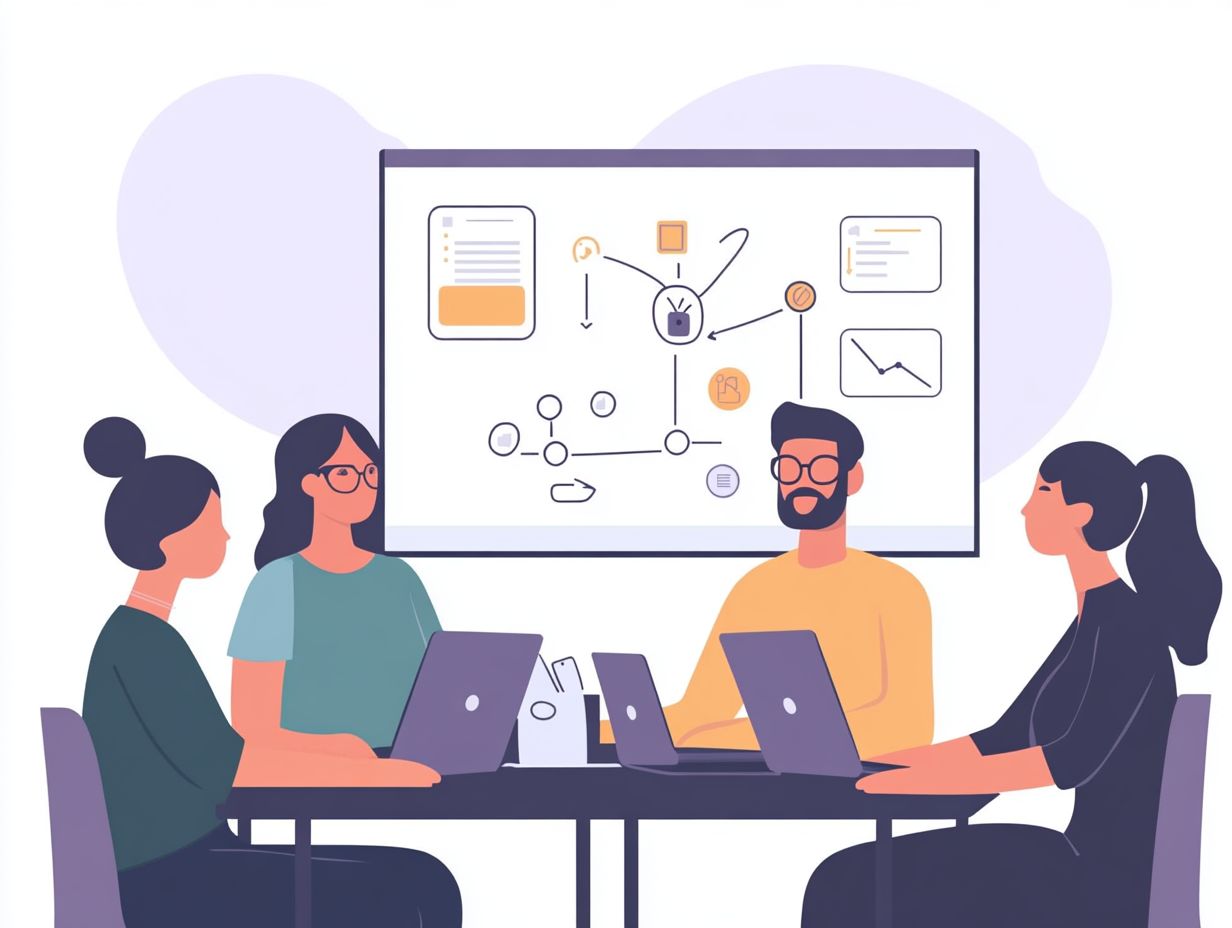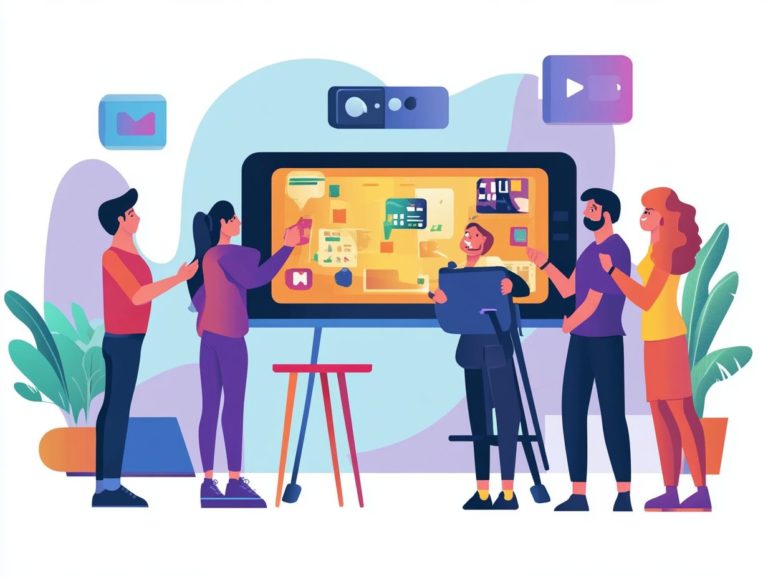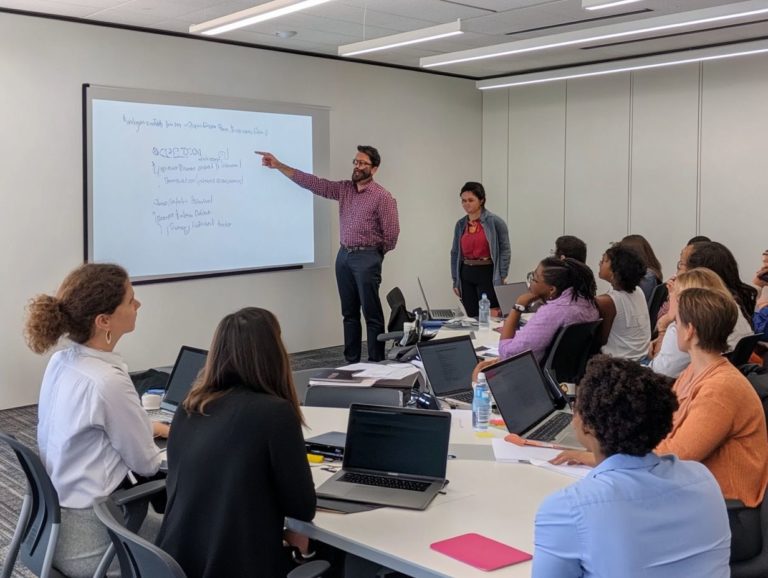How to Design a Learning Path for Employees?
Today s fast-paced workplace makes understanding and meeting employee learning needs essential.
This article will guide you through designing a comprehensive learning path, beginning with identifying knowledge and skill gaps.
You will discover how to establish clear goals and select the right learning methods specifically tailored to your team.
Explore effective training strategies, techniques to track progress, and ways to evaluate the impact of your learning initiatives.
Learn how to cultivate a culture of continuous education and growth, ensuring your employees excel in their roles.
Take action now to empower your workforce and achieve remarkable success!
Contents
- Key Takeaways:
- Understanding Employee Learning Needs
- Creating a Learning Path
- Implementing the Learning Path
- Evaluating the Effectiveness of the Learning Path
- Continuing Education and Growth Opportunities
- Frequently Asked Questions
- What are the key elements to consider when designing a learning path for employees?
- How do you determine the specific training needs of employees for a learning path?
- What is the role of managers in the design of a learning path for employees?
- How can technology be incorporated into a learning path for employees?
- What are some effective ways to engage employees in a learning path?
- How can the success of a training program for employees be measured?
Key Takeaways:

- Identify knowledge and skill gaps of employees to design an effective learning path.
- Set clear goals and objectives before choosing appropriate learning methods and resources for employees.
- Implement and track the progress of the learning path, and evaluate its effectiveness through employee performance and retention measures.
Understanding Employee Learning Needs
Understanding your employees’ learning needs is crucial for creating effective learning paths that specifically target skill gaps and enhance engagement.
By pinpointing precise learning objectives and aligning them with your organizational goals, you can develop tailored training content that fosters skill development and promotes continuous growth among your team members.
In today s rapidly changing business world, recognizing these needs is vital for nurturing a culture of learning within the organization and adapting to emerging industry trends.
Identifying Knowledge and Skill Gaps
Identifying your knowledge and skill gaps is essential for effective competency development within your organization. Without a clear understanding of these gaps, your teams may struggle to enhance their capabilities, significantly hindering overall productivity.
You can employ various methods for conducting skill assessments. For instance, performance evaluations and self-assessments provide valuable insights into individual competencies, while peer reviews can illuminate strengths and weaknesses in teamwork. Implementing practical tests or simulations allows you to observe skills in action, giving you a real-time perspective on capabilities.
Grasping the skills gap not only helps you tailor training initiatives but also nurtures a culture of continuous improvement. This approach ultimately benefits both your employees and the organization as a whole.
Creating a Learning Path
Crafting a learning path tailored to your individual needs demands a deep understanding of personalized learning principles and the establishment of clear objectives that illuminate your learning journey.
By incorporating methods that adjust to individual learning styles and providing opportunities for self-paced study, organizations can ensure that the curriculum aligns seamlessly with the diverse requirements of their workforce. This approach enhances skill acquisition and fosters greater employee engagement in the development strategy.
Setting Goals and Objectives
Setting clear learning objectives is vital for driving employee engagement and ensuring that training aligns seamlessly with individual aspirations and organizational goals.
Thoughtfully crafted objectives act as a roadmap for the training journey and serve as benchmarks for measuring success. By concentrating on specific, measurable outcomes, you enable employees to grasp what is expected and how their efforts contribute to broader performance metrics.
Clear learning objectives cultivate a culture of continuous improvement, inspiring individuals to pursue new skills and competencies that facilitate personal and professional growth. This alignment between training initiatives and organizational strategies ultimately boosts productivity and nurtures a more agile workforce, one that can swiftly adapt to evolving challenges.
Choosing Learning Methods and Resources

Choosing the right learning methods can significantly improve your training programs and boost knowledge retention.
Explore various approaches that cater to different learning styles. Microlearning, for example, delivers information in small, digestible pieces.
Platforms like LinkedIn Learning offer short video courses that fit into your busy schedule, allowing you to learn at your own pace.
Peer-to-peer learning fosters collaboration. This method lets individuals share experiences, enriching the learning process.
E-learning platforms like Coursera and Udemy provide a variety of courses tailored to workplace skills. Choose content that aligns with your training objectives for maximum impact.
Implementing the Learning Path
Implementing the learning path requires executing training programs that actively engage employees and promote effective change management within your organization.
By leveraging robust internal communication channels and establishing effective feedback mechanisms, you can ensure a seamless transition to the training initiatives.
This approach will ultimately enhance employee performance and drive organizational success.
Training and Development Strategies
Effective training and development strategies are essential for enhancing your competencies and boosting performance within your organization.
A well-structured training program does more than just upgrade skills; it nurtures a culture of continuous learning that benefits everyone.
Among the various initiatives available, mentoring programs shine brightly, offering personalized guidance and support from seasoned peers.
These programs foster knowledge sharing and can significantly speed up your professional growth.
Workshops and online courses provide the flexibility you need and cater to diverse learning styles, ensuring opportunities to thrive.
By combining these strategies, organizations can cultivate a more skilled workforce, ultimately driving higher levels of engagement and productivity for everyone involved.
Tracking Progress and Adjusting as Needed
Tracking your progress and making necessary adjustments is crucial for ensuring that your training programs remain effective and aligned with your performance impact goals.
To achieve this, using tools that help you understand how well people are learning can provide valuable insights into individual and group performance.
By utilizing skill inventories, you can better assess competencies against established benchmarks, fostering a targeted approach to development.
Incorporating continuous feedback mechanisms not only facilitates real-time assessment but also empowers you as a learner by promoting an iterative learning cycle.
This dynamic process allows you to make quick adjustments to keep learning relevant and effective.
Evaluating the Effectiveness of the Learning Path
Evaluating the effectiveness of your learning path requires a thoughtful approach to measuring employee performance and assessing knowledge retention.
This process allows you to gauge the overall impact of your training initiatives, ensuring they meet your organizational goals and foster a culture of continuous improvement.
Measuring Employee Performance and Retention

Measuring employee performance and knowledge retention offers invaluable insights into the effectiveness of training programs. It also helps to pinpoint existing skills gaps.
These metrics act as a guiding plan for your organization. They help elevate workforce capabilities and align them seamlessly with your business objectives.
By utilizing key performance indicators (KPIs), or measurable values that show how effectively you are achieving your business objectives, such as productivity levels, quality of work, and engagement scores, you can easily identify high-performing employees and those who might need extra support.
Monitoring knowledge retention through assessments and feedback loops ensures that your staff consistently builds upon their existing expertise. This focus on skill development cultivates a vibrant culture of learning, preparing your organization to adapt to shifting market conditions and technological advancements. Ultimately, this drives your success forward.
Continuing Education and Growth Opportunities
Continuing education and growth opportunities are essential for nurturing ongoing learning. They help you stay engaged and motivated in your professional development.
Investing in your knowledge enhances your skills and fuels your career advancement, making it a pivotal element in your journey toward success.
Encouraging Ongoing Learning and Development
Encouraging ongoing learning and development is essential for maintaining high levels of employee engagement. It cultivates a thriving learning culture within your hybrid workplace.
You can spark growth by implementing exciting training programs tailored for your team. By integrating various learning methodologies such as online courses, interactive workshops, and mentorship opportunities you create an environment that fosters continuous improvement.
Regular feedback and recognition of achievements are vital in motivating you to pursue professional growth. Establishing clear pathways for career advancement further incentivizes you to take ownership of your learning journey, driving personal satisfaction while contributing to your organization s success.
Frequently Asked Questions
What are the key elements to consider when designing a learning path for employees?
When designing a learning path for employees, consider the company’s goals and objectives, the employees’ current skills and knowledge, the available resources and technology, and the desired learning outcomes.
How do you determine the specific training needs of employees for a learning path?

The best way to determine the training needs of employees is to conduct a thorough assessment. This may include surveys, performance evaluations, and job analysis to identify knowledge and skill gaps that need to be addressed.
What is the role of managers in the design of a learning path for employees?
Managers play a crucial role in designing a learning path for employees. They provide valuable insights into the specific skills and knowledge their team needs to develop, as well as support and encouragement throughout the learning process.
How can technology be incorporated into a learning path for employees?
Technology can be incorporated into a learning path for employees through various methods, such as e-learning modules, virtual training sessions, and online resources. It can also track employee progress and provide personalized learning experiences.
What are some effective ways to engage employees in a learning path?
To engage employees in a learning path, make the training relevant and interactive. This can include using real-life scenarios, incorporating gamification elements, and providing opportunities for employees to apply their new knowledge and skills in their work.
How can the success of a training program for employees be measured?
You can measure the success of a training program using different methods. Examples include assessments before and after training, employee feedback surveys, and tracking performance improvements.
Setting clear learning goals is crucial. Regularly check your progress to ensure you re on the right track to success!






